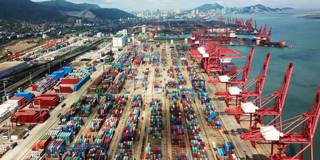Although 2020 ended with a flurry of announcements reporting promising results in COVID-19 vaccine trials, there is little reason to expect a robust economic recovery anytime soon. Defeating the virus remains a monumental task, and the wounds inflicted by the pandemic will not heal easily.
NEW YORK – By the end of 2020, financial markets – mostly in the United States – had reached new highs, owing to hopes that an imminent COVID-19 vaccine would create the conditions for a rapid V-shaped recovery. And with major central banks across the advanced economies maintaining ultra-low policy rates and unconventional monetary and credit policies, stocks and bonds have been given a further boost.
But these trends have widened the gap between Wall Street and Main Street, reflecting a K-shaped recovery in the real economy. Those with stable white-collar incomes who can work from home and draw from existing financial reserves are doing well; those who are unemployed or partly employed in precarious low-wage jobs are faring poorly. The pandemic is thus sowing the seeds for more social unrest in 2021.
In the years leading up to the COVID-19 crisis, 84 of stock-market wealth in the US was held by 10% of shareholders (and 51% by the top 1%), whereas the bottom 50% held barely any stock at all. The top 50 billionaires in the US were wealthier than the bottom 50% of the population (a cohort of about 165 million people). COVID-19 has accelerated this concentration of wealth, because what’s bad for Main Street is good for Wall Street. By shedding good salaried jobs and then re-hiring workers on a freelance, part-time, or hourly basis, businesses can boost their profits and stock price; these trends will accelerate over time with the wider application of artificial intelligence and machine learning (AI/ML) and other labor-replacing, capital-intensive, skill-biased technologies.

NEW YORK – By the end of 2020, financial markets – mostly in the United States – had reached new highs, owing to hopes that an imminent COVID-19 vaccine would create the conditions for a rapid V-shaped recovery. And with major central banks across the advanced economies maintaining ultra-low policy rates and unconventional monetary and credit policies, stocks and bonds have been given a further boost.
But these trends have widened the gap between Wall Street and Main Street, reflecting a K-shaped recovery in the real economy. Those with stable white-collar incomes who can work from home and draw from existing financial reserves are doing well; those who are unemployed or partly employed in precarious low-wage jobs are faring poorly. The pandemic is thus sowing the seeds for more social unrest in 2021.
In the years leading up to the COVID-19 crisis, 84 of stock-market wealth in the US was held by 10% of shareholders (and 51% by the top 1%), whereas the bottom 50% held barely any stock at all. The top 50 billionaires in the US were wealthier than the bottom 50% of the population (a cohort of about 165 million people). COVID-19 has accelerated this concentration of wealth, because what’s bad for Main Street is good for Wall Street. By shedding good salaried jobs and then re-hiring workers on a freelance, part-time, or hourly basis, businesses can boost their profits and stock price; these trends will accelerate over time with the wider application of artificial intelligence and machine learning (AI/ML) and other labor-replacing, capital-intensive, skill-biased technologies.